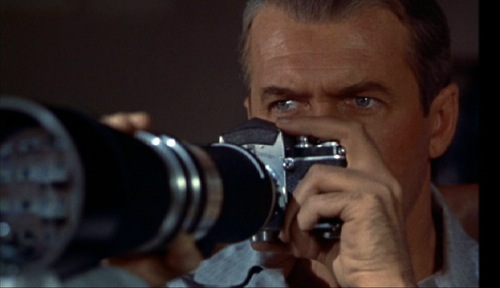Longtime readers of this blog (and I take it on faith that there are one or two of you out there) will know that I am obsessed with the clumsy sublime, Laura Mulvey’s term for the accidental beauty of old-school special effects in classical Hollywood — studio tricks and machinations meant to pass unnoticed in their time, but which become visible and available for fresh appreciation as years go by and the state of the art evolves.
The same reader(s) will be familiar with my interest in virtual spaces and more specifically with the “pocket universes” of storyworlds and certain photographic experiments, such as the one featured in this post on the 2008 Republican National Convention. Well, now I’ve found a new toy to think with: this lovely virtualization of the courtyard in Rear Window (1954), digitally stitched together to recreate not just the large and elaborate studio set on which Alfred Hitchcock filmed the tale of L. B. Jefferies (James Stewart), whose immobilization by broken leg unlocks a visual mobility in which he scans through binoculars the social (and as it turns out, criminal) microcosm of the neighbors in his apartment complex. Here’s the video:
Within this composited space, part Holodeck, part advent calendar, the action of the movie unfolds with new seamlessness and unity, time’s passage marked by sunrises and sunsets, clouds rippling overhead, the moon rising on its nighttime trajectory as the small community bustles through an overlapping ballet of the quotidian. In the middle of it all, a harried husband builds to a murderous rage, disposes of a body, is investigated by Grace Kelly sneaking in from a fire escape.
One of Hitchcock’s undisputed masterpieces, Rear Window is also the go-to example in introductory film courses to illustrate voyeurism, scopophilia, and the cinematic apparatus — a raft of abstract yet efficacious concepts that come out of the “grand theory” tradition of film studies, themselves subject, perhaps, to their own form of clumsy sublimation. I wonder how we might update those ideas in an era of computational revisitation and transformation, in which the half-built, half-imagined territories of classical cinema can be unfolded into digital origami that simultaneously make them more “real” while rendering apparent their intricate artificiality, recoding cinema’s dreamspaces into simulacral form.


Like the ‘advent calendar’ bit–and the idea of ‘clumsy sublime’ (new to me). Great to look at this video in a thoughtful way. I saw it a few days ago and didn’t think much of it, but reading this adds a lot to it.
About the digital revisiting, that brought to mind Steve Martin’s ‘Dead Men Don’t Wear Plaid’. I’m not sure just how, but seems like the underlying schtick of that movie is a similar exploration/enjoyment/ode to classical Hollywood, though perhaps in a more general way.
Steve, thanks for your comments; I’m glad my post added a little coolness to the video for you. How fun that you bring up Dead Men Don’t Wear Plaid — I remember watching it as a kid (hmm, it was released in 1982, making me [and you too, I assume?] 15 or 16 at the time) and being more interested in Rachel Ward’s figure than in Martin’s clever pastiche. But you’re right, that movie prefigured “classier” raidings of the past like Zelig (1983) and Forrest Gump (1994) — the latter trumpeted as a digital-effects film but following a similar impulse to mix and match its temporalities. Of course, those two weren’t as invested in a specifically cinematic history as was Dead Men. Along those lines, did you see Hugo? I’m about to write a capsule review of it …
BTW, Mulvey’s full piece on the clumsy sublime (still only a single page) can be found here.